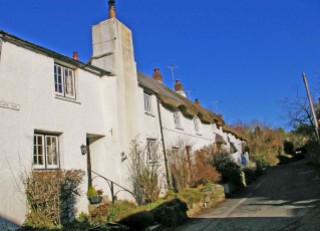History of Kingston
Kingston Timeline is HERE.
Kingston is a coastal parish on the South Coast of Devon, on the eastern side of the Erme estuary, with the village itself situated a mile inland. Part of the parish boundary follows the limits of land defined in a Saxon Charter of King Aethelwulf ca.846.
In 1086 Kingston was still in royal ownership, but was part of Ermington, and had no separate entry in the Domesday Book. It ceased to be a royal possession in 1276 when Henry 1 gave it to Matilda Peverel, and it became part of the ecclesiastic parish of Ermington, Kingston Church being the daughter Church of Ermington. Members of the Peverel family were Lords of the Manor for two centuries, but they never lived in Kingston.
The land in the middle of the parish was let to tenant farmers, most of who lived in the village, and the outlying farms were freehold properties. The Manor lands were cultivated in large fields which were divided into strips, the farmers being apportioned these in various locations throughout the parish. These open fields were enclosed before the middle of the eighteenth century, being replaced by narrow fields, bounded by hedges following the medieval pattern. Some of these fields survived until after the Second World War, but since then many hedges have been removed to form large fields once again.
 There are few early records of Kingston. In about 1250 Ralph de Punchardon granted Ellis le Brun one furlong of land in ‘Kyngeston’ with “free pasture for all beasts” and the right to search for sand at ‘Schobescumb’ for a yearly rent of 5s. In 1269 Roberto de Wuniewill was witness to a deed involving the alien priory of Modbury. In 1291 there was a court case concerning the unlawful holding of land in Kingston belonging to William Martyn, the lord of the Manor. In 1524 forty-five men and two women were assessed for taxes to finance the war with France, and in 1596 fifty-one Kingston men were shown to be liable for war service during the threat of invasion.
There are few early records of Kingston. In about 1250 Ralph de Punchardon granted Ellis le Brun one furlong of land in ‘Kyngeston’ with “free pasture for all beasts” and the right to search for sand at ‘Schobescumb’ for a yearly rent of 5s. In 1269 Roberto de Wuniewill was witness to a deed involving the alien priory of Modbury. In 1291 there was a court case concerning the unlawful holding of land in Kingston belonging to William Martyn, the lord of the Manor. In 1524 forty-five men and two women were assessed for taxes to finance the war with France, and in 1596 fifty-one Kingston men were shown to be liable for war service during the threat of invasion.
In 1596 an Act required parishes to look after their paupers, and the accounts of the Overseers from the mid 17th century to the early 19th century are kept in the Devon Record Office at Exeter. The money to support the poor was drawn from rates paid by parishioners. Lawbreakers were taken to Plympton to be tried, and fathers of illegitimate children were to provide maintenance. Orphans were boarded with neighbours, children were sent to school, and at the age of eleven or twelve they were apprenticed, usually to local farmers.
The early 19th century censuses give detailed accounts of all the people living in the parish. Most of the men and some of the women worked on the land, but there were many other tradesmen in what was a self contained community. There were masons, carpenters, fishermen and coastguards, blacksmiths, tailors and dressmakers, cobblers, a maltster, a limeburner, and a carrier, as well as shops, and by 1850 a post office, ( which finally closed in 2004). In 1765 Benjamin Donn’s Map of Devon shows the “New Inn” at Kingston. This was later called the “Brittania Inn”. The current pub in the village “The Dolphin” was originally owned by John Ryder. In the 1841 and 1851 censuses he was shown as a “farmer”, but in 1861 he is described as a “victualler”, and was obviously selling cider and other drinks.
There are mentions of small private schools from 1779 onwards. In 1818 the incumbent reported that there were “3 or 4 schools at parents’ expense, with 28 children in all”. In 1851 the children attended the Erme and Avon school at Bigbury. A “National” (Church) day school was established in 1860, but the records are somewhat sketchy at this time. In 1871 at a Vestry meeting it was agreed that the post of a schoolmaster was to be advertised “offering £30 a year, in addition to the School Pence”. In 1875 there was an inspection of the Kingston School Board, “and although the building had not yet been decorated, there was a good attendance of children, and the Inspector expressed himself well pleased with the school-room and general arrangements”. The school was to remain open until July 1966.
Much of this information has been taken from various publications by Mary Petter and the Kingston Local History Society, and the Society’s Archives.
There are 23 listed buildings in the parish.
1. No 1 Bay Cottages
2. Boundary stone near former boathouse @ Wonwell beach
3. Butterwell opposite Robins Farm
4. Church of St James The Less
5. Churchyard Cross
6. Donkey Stable opposite Robins Farm
7. Hillside
8. Honeysuckle Cottage Nos 1 to 5 + boundary wall and steps (chapel Row)
9. Ivy Cottage
10. Kingston War Memorial
11. Langston Farmhouse
12. Lower Shearlangstone. NOTE incorrect address this is Torr House.
13. Okenbury Farmhouse
14. Park Cottage.
15. Robins Cottage
16. Robins Farm
17. Thatched Cottage, Torr
18. The Dolphin Inn
19. The Farriers
20. The Old Forge
21. Torr Cottage, Torr
22. Walkspool.
23. Wonwell Court.
